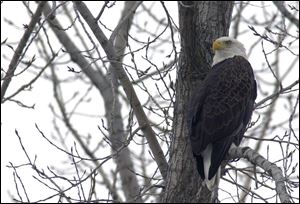
Bald eagle population on the rise, state says
1/27/2005
America's once-endangered bald eagle is thriving in northwest Ohio.
OAK HARBOR, Ohio - Ohio's bald eagle-recovery efforts remain strong, with protected western Lake Erie's wetland marshes continuing to show their ecological value to America's once-endangered national symbol.
Sandusky, Erie, and Ottawa counties again posted the highest numbers in the state in the annual midwinter bald eagle survey. The Ohio Department of Natural Resources released results of the two-week survey Tuesday.
"Ohio's bald eagle population continues to expand throughout the state," said Steven Gray, the Ohio DNR's wildlife division chief.
Eagles were observed in 55 of Ohio's 88 counties. Mr. Gray and other officials have long attributed the comeback to stronger conservation efforts, as well as the 1972 ban on DDT spraying in the United States.
DDT, stockpiled during World War II because of its effectiveness as a pesticide capable of battling malaria and other diseases, became one of the first chemicals that scientists linked to cancer following the publication of Rachel Carson's landmark 1962 book, Silent Spring.
The late Ms. Carson, a former aquatic biologist for the U.S. Fish and Wildlife Service, was lauded by Time magazine as one of the most influential people of the 20th Century for awakening the scientific community to the dangers of chemical overexposure.
The federal ban on DDT significantly helped eagle-recovery efforts nationwide. DDT had made it difficult for eagles to reproduce, because contaminated birds laid eggs with shells that were too thin and more vulnerable to cracking. It is still used in tropic countries.
This year's midwinter tally of 366 eagles in Ohio was a near-record. Last year, 372 eagles were observed. But the ratio of young birds to old birds improved.
Last year, there were more than three adult eagles for every eagle that was believed to be less than five years old. This winter, there were about two adults for every eagle under five.
State wildlife officials conduct the survey each January as part of a national effort coordinated by the Fish and Wildlife Service. The survey documents trends in the lower 48 states of the bald and the golden eagles. Golden eagles are rarely seen in Ohio, although one was observed this year at an undisclosed location, the Ohio DNR said.
Alaska has the greatest number of bald eagles in the United States, with estimates often between 30,000 and 40,000 birds.
Area volunteers interested in monitoring eagle nests in Ohio this spring are encouraged to attend one of three training workshops. The first is Sunday at Killdeer Plains State Wildlife Area in Wyandot County. Another will be Feb. 3 in Trumbull County, and the last will be Feb. 6 in Ottawa County at Carroll Township Hall north of Oak Harbor.
For times and registration information for the workshops in Wyandot and Ottawa counties, call Mark Shieldcastle at the Ohio DNR's Crane Creek Wildlife Research Station, 419-898-0960. For the Trumbull County workshop, call the Ohio DNR's at 330-644-2293.
Contact Tom Henry at:
thenry@theblade.com
or 419-724-6079.